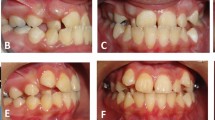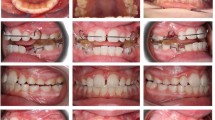Abstract
Data sources
The Cochrane Central Register of Controlled Trials, Cochrane Database of Systematic Reviews, Embase, Medline and the ClinicalTrials.gov databases.
Study selection
Randomised controlled trials (RCTs) and controlled clinical trials (CCTs) of children aged 7–12 years with class III malocclusion undergoing fixed or removable orthodontic treatment for early correction were included.
Data extraction and synthesis
Two reviewers independently selected studies, abstracted data and assessed risk of bias. The Cochrane risk of bias tool was used for RCTs and the Downs and Black and the Newcastle-Ottawa scales for CCTs. The primary outcome was correction of reverse overjet. Mean differences (MD) with 95% confidence intervals were calculated and a random effects meta-analysis conducted.
Results
Fifteen studies (nine RCTs, six CCTs) were included. Only three of the RCTs were considered to be at low risk of bias, all six CCTs were at high risk of bias.Three RCTs (141 patients) compared protraction facemask and untreated control. The results for reverse overjet (MD = 2.5 mm; 95% CI, 1.21–3.79) and ANB angle (MD = 3.90˚; 95% CI, 3.54–4.25) were statistically significant favouring the facemask group. All CCTs demonstrated a statistically significant benefit in favour of the use of each appliance. However, the studies had high risk of bias.
Conclusions
There is a moderate amount of evidence to show that early treatment with a facemask results in positive improvement for both skeletal and dental effects in the short term. However, there was lack of evidence on long-term benefits. There is some evidence with regard to the chincup, tandem traction bow appliance and removable mandibular retractor, but the studies had a high risk of bias. Further high-quality, long-term studies are required to evaluate the early treatment effects for Class III malocclusion patients.
Similar content being viewed by others
Commentary
Class III malocclusion affects approximately 5% of the British population.1, 2, 3 Early interceptive orthodontic treatment aimed at influencing the way the malocclusion develops and reducing the complexity of subsequent treatment has long been practised. However, as with other orthodontic interceptive treatment modalities, the evidence to support its efficacy is equivocal. Recently, well-conducted, high level studies to support early correction of Class III malocclusion have been published. Hence, this review is timely and relevant to all dental practitioners.
The timing of early treatment for Class III malocclusion is important, with some suggesting that this should be before ten years of age in order to optimise the potential for orthopaedic changes.4, 5,6 Thus, it is important that all dentists routinely assess patients and consider early referral to an orthodontist where relevant. A wide range of appliances has been used to achieve correction including facemask, chincup, Frankel FR-3, reverse Twin-block and Class III elastics.
The aim of the recent systematic review considered in this commentary was to evaluate the effectiveness of orthodontic methods used in the early treatment of Class III malocclusion in the short and long terms and to compare different methods and appliances. It builds upon a previous Cochrane Review by Watkinson and colleagues, which found some evidence that the use of a facemask to correct prominent lower front teeth in children is effective when compared to no treatment on a short-term basis, with outcomes reported at both 15 months and three years after treatment commenced.7
The review was not a Cochrane Review but it was conducted with a similar protocol. The question, inclusion criteria and search strategy were clearly defined and a reasonable publication-date restriction was applied. Several sources were used to identify all relevant studies independently of language. The Cochrane Central Register of Controlled Trials, Cochrane Database of Systematic Reviews, Embase, and Medline (Ovid) were searched to April 2016 using appropriate search terms. Randomised controlled trials (RCTs) and controlled clinical trials (CCTs) of children aged 7-12 years with class III malocclusion undergoing fixed or removable orthodontic treatment for early correction were considered. The inclusion of CCTs differs from the previous Cochrane Review which only included RCTs.7 Data extraction was carried out by two reviewers independently. Of the 2417 studies initially identified only fifteen studies (nine RCTs and six CCTs) were included in the final review. The results of the studies are combined and grouped in a way that makes interpretation a little cumbersome.
Of the studies included, only three of the RCTs were judged as having low risk of bias. Five RCTs were judged as having unclear risk of bias and one RCT was judged as having high risk of bias. All CCTs included had high risk of bias due to the lack of sample size calculations and blinding. The results include three year follow-up results from one of the RCTs included in the Cochrane Review7 and further supports the earlier findings and effectiveness of early correction at the three-year interval.8
The primary outcome of the effects of early treatment was correction of reverse overjet, measured in millimetres. Secondary outcomes were skeletal changes, soft tissue changes, quality of life, patient compliance, adverse effects, Peer Assessment Rating score and treatment time. Three RCTs with a total of 141 participants compared protraction facemask with untreated controls. Only Mandall et al. reported the primary outcome, finding a statistically significant overjet mean difference of 2.5mm (P=0.001), which was maintained at a three-year review.8 However, the majority of studies included did not report overjet as an outcome measure, tending to report cephalometric values such as ANB changes, which reflect a change in the maxilla/mandible relationship.
In studies that compared different appliances, two found statistically significant differences for ANB changes, Keles et al. comparing conventional facemask with modified protraction headgear,9 and Showkatbakhsh et al. comparing facemask with tongue plate appliance, finding greater changes in the tongue plate group.10 Three other studies found no significant difference between various appliances.11, 12, 13 Interestingly, subsequent to the data extraction for the systematic review, the Mandall team reported 68% of the facemask group maintained a positive overjet at six-year follow-up, however only just, with a mean overjet of 0.8mm, indicating some relapse.14 The primary outcome measure used in the six-year review of the RCT was need for orthognathic surgery. This was assessed based on clinical records of photographs, overjet measurement and cephalometric variables by a panel of seven consultant orthodontists, who came to a group decision of ‘yes’ or ‘no’ for the need for orthognathic surgery. This has the potential limitation of subjectivity and bias being introduced but is quite realistic of how clinical decisions are often made.14 Furthermore, when cephalometric parameters of skeletal change were assessed, almost all of the skeletal improvement did relapse and there were no statistically significant differences for antero-posterior skeletal change between the treatment and control groups at six-year recall.14
One reason debate still exists on the subject of early Class III correction is because of the difficulties in carrying out the ideal study with untreated control groups. The authors identify the main hurdle for early Class III treatment studies as the delay in treatment for control subjects. Also, patients need to be followed until the age of 16 or 17 when mandibular growth ceases, to evaluate any real benefit. This increases the cost to parents and burdens participant compliance, which can lead to high dropout rates. Other issues include having to start treatment early, as young as eight years of age, and the associated issues with referral and compliance that brings.
Orthodontists have long debated the merits of early intervention in the management of malocclusion, for example early functional appliance therapy or correction of crossbites with mandibular displacement, but the existing evidence base is generally weak.15, 16 Early treatment of Class III malocclusion is another area worthy of investigation and overall this well conducted systematic review shows that there is moderate quality evidence to support the benefits of treatment with a facemask in the short term. However, as is frequently the conclusion of such reviews, further high quality, long-term studies are required to evaluate the early treatment effects and long-term benefits of this treatment. Paradoxically, as more evidence emerges to support the benefits of early correction of Class III malocclusion, it may become ethically more challenging to justify conducting randomised controlled trials and withholding treatment that has a proven benefit.
Practice point
-
Increasing body of evidence to show that early treatment with a facemask to correct Class III malocclusion results in positive improvement in both skeletal and dental relationship in the short term
-
Further high-quality, long-term studies are required to evaluate the early treatment effects and long-term benefits.
References
Goose DH, Thomson DG, Winter FC . Malocclusion in school children of the west Midlands. Br Dent J 1957; 102: 174–78.
Haynes S . The prevalence of malocclusion in English children aged 11-12 years. Rep Congr Eur Orthod Soc 1970: 89–98.
Foster TD, Day AJ . A survey of malocclusion and the need for orthodontic treatment in a Shropshire school population. Br J Orthod 1974; 1: 73–78.
Battagel JM, Orton HS . A comparative study of the effects of customized facemask therapy or headgear to the lower arch on the developing Class III face. Eur J Orthod 1995; 17: 467–482.
Baccetti T, Tollaro I . A retrospective comparison of functional appliance treatment of Class III malocclusions in the deciduous and mixed dentitions. Eur J Orthod 1998; 20: 309–317.
Kim JH, Viana MA, Graber TM, Omerza FF, BeGole EA . The effectiveness of protraction face mask therapy: a meta-analysis. Am J Orthod Dentofacial Orthop 1999; 115: 675–685.
Watkinson S, Harrison JE, Furness S, Worthington HV . Orthodontic treatment for prominent lower front teeth (Class III malocclusion) in children. Cochrane Database Syst Rev 2013: CD003451.
Mandall N, Cousley R, DiBiase A, Dyer F, Littlewood S, Mattick R, et al. Is early Class III protraction facemask treatment effective? A multicentre, randomized, controlled trial: 3-year follow-up. J Orthod 2012; 39: 176–185.
Keles A, Tokmak EC, Erverdi N, Nanda R . Effect of varying the force direction on maxillary orthopedic protraction. Angle Orthod 2002; 72: 387–396.
Showkatbakhsh R, Toumarian L, Jamilian A, Sheibaninia A, Mirkarimi M, Taban T . The effects of face mask and tongue plate on maxillary deficiency in growing patients: a randomized clinical trial. J Orthod 2013; 40: 130–136.
Vaughn GA, Mason B, Moon HB, Turley PK . The effects of maxillary protraction therapy with or without rapid palatal expansion: a prospective, randomized clinical trial. Am J Orthod Dentofacial Orthop 2005; 128: 299–309.
Abdelnaby YL, Nassar EA . Chin cup effects using two different force magnitudes in the management of Class III malocclusions. Angle Orthod 2010; 80: 957–962.
Liu W, Zhou Y, Wang X, Liu D, Zhou S . Effect of maxillary protraction with alternating rapid palatal expansion and constriction vs expansion alone in maxillary retrusive patients: a single-center, randomized controlled trial. Am J Orthod Dentofacial Orthop 2015; 148: 641–651.
Mandall N, Cousley R, DiBiase A, Dyer F, Littlewood S, Mattick R, et al. Early class III protraction facemask treatment reduces the need for orthognathic surgery: a multi-centre, two-arm parallel randomized, controlled trial. J Orthod 2016; 43: 164–175.
Thiruvenkatachari B, Harrison JE, Worthington HV, O'Brien KD . Orthodontic treatment for prominent upper front teeth (Class II malocclusion) in children. Cochrane Database Syst Rev 2013 (11): CD003452.
Agostino P, Ugolini A, Signori A, Silvestrini-Biavati A, Harrison JE, Riley P . Orthodontic treatment for posterior crossbites. Cochrane Database Syst Rev 2014 (8): CD000979.
Author information
Authors and Affiliations
Additional information
Address for correspondence: Badri Thiruvenkatachari, School of Dentistry, JR Moore Building, University of Manchester, Manchester, UK, M13 9PL E-mail: Badri.T@manchester.ac.uk.
Woon SC, Thiruvenkatachari B. Early orthodontic treatment for Class III malocclusion: A systematic review and meta-analysis. Am J Orthod Dentofacial Orthop 2017; 151: 28–52.
Rights and permissions
About this article
Cite this article
Smyth, R., Ryan, F. Early treatment of class III malocclusion with facemask. Evid Based Dent 18, 107–108 (2017). https://doi.org/10.1038/sj.ebd.6401269
Published:
Issue Date:
DOI: https://doi.org/10.1038/sj.ebd.6401269



